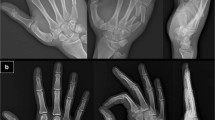Abstract
Objective
The purpose of this prospective study was to examine the temperament dimensions of the patients with boxer fracture and compare them with age- and sex-matched controls.
Methods
We performed a prospective analysis investigating affective temperaments of the 102 patients with boxer fractures and compared them with 100 sex- and age-matched controls that were referred to the emergency department due to incidental soft-tissue trauma. Affective temperament of the patients was evaluated by Memphis, Pisa, Paris, and San Diego-Auto questionnaire (TEMPS-A). Both incidences of dominant affective temperaments of boxer fracture cases with previously validated normal Turkish population and controls and differences between mean values of temperament scores were analyzed.
Results
The mean age of the patients with boxer fractures was 25.6 (range 17–47) and 27.7 years (range 17–49) for controls. We found that dominant irritable temperament (n = 10; 9.7%) had significantly higher incidence from both control group and normal Turkish population (p < 0.001). In addition, there was significant difference between anxious temperament scores of two groups (p = 0.013).
Conclusion
The understanding of mood of patients with boxer fractures will help us to enhance treatment plan and may prevent further intentional injuries by providing an insight into better controlling physical health of the patients.
Similar content being viewed by others
References
Greer SE, Williams JM. Boxer’s fracture: an indicator of intentional and recurrent injury. Am J Emerg Med. 1999;17:357–60.
Altizer L. Boxer’s fracture. Orthop Nurs. 2006;25:271–3.
Haw C, Hawton K, Houston K, Townsend E. Psychiatric and personality disorders in deliberate self-harm patients. Br J Psychiatry. 2001;178:48–54.
Klonsky ED, Oltmanns TF, Turkheimer E. Deliberate self-harm in a nonclinical population: prevalence and psychological correlates. Am J Psychiatry. 2003;160:1501–8.
Akiskal HS. Toward a temperament-based approach to depression: implications for neurobiologic research. Adv Biochem Psychopharmacol. 1995;49:99–112.
Akiskal HS, Akiskal KK. In search of Aristotle: temperament, human nature, melancholia, creativity and eminence. J Affect Disord. 2007;100:1–6.
Akiskal HS, Mendlowicz MV, Jean-Louis G, Rapaport MH, Kelsoe JR, Gillin JC, et al. TEMPS-A: validation of a short version of a self-rated instrument designed to measure variations in temperament. J Affect Disord. 2005;85:45–52.
Goto S, Terao T, Hoaki N, Wang Y. Cyclothymic and hyperthymic temperaments may predict bipolarity in major depressive disorder: a supportive evidence for bipolar II1/2 and IV. J Affect Disord. 2011;129:34–8.
Maremmani I, Dell’Osso L, Rovai L, Arduino G, Montagnari A, Abbenante D, et al. Discriminant and convergent validity of TEMPS-A[P] correlation with MMPI and the emotional-affective state following a stressful situation. J Affect Disord. 2011;129:27–33.
Walsh MA, Brown LH, Barrantes-Vidal N, Kwapil TR. The expression of affective temperaments in daily life. J Affect Disord. 2013;145:179–86.
Mercan S, Uzun M, Ertugrul A, Ozturk I, Demir B, Sulun T. Psychopathology and personality features in orthopedic patients with boxer’s fractures. Gen Hosp Psychiatry. 2005;27:13–7.
Vahip S, Kesebir S, Alkan M, Yazici O, Akiskal KK, Akiskal HS. Affective temperaments in clinically-well subjects in Turkey: initial psychometric data on the TEMPS-A. J Affect Disord. 2005;85:113–25.
Nakashian MN, Pointer L, Owens BD, Wolf JM. Incidence of metacarpal fractures in the US population. Hand (N Y). 2012;7:426–30.
Moore DJ, Atkinson JH, Akiskal H, Gonzalez R, Wolfson T, Grant I; HNRC Group. Temperament and risky behaviors: a pathway to HIV? J Affect Disord. 2005;85:191–200.
Author information
Authors and Affiliations
Corresponding author
Ethics declarations
Conflict of interest
Anıl taşkesen, İsmail Demirkale, Nermin Taşkesen, Mehmet Okumuş, and Devrim Öztürk Can declare that they have no conflict of interest.
Funding
The authors received no financial support for the research and/or authorship of this article.
Research involving human participants and/or animals
Approval was sought and obtained from the hospital IRB (No. 0624–5223).
Informed consent
Informed consent was obtained from patients for study participation.
Rights and permissions
About this article
Cite this article
Taşkesen, A., Demirkale, İ., Taşkesen, N. et al. Irritable temperament profile prevails among patients with boxer fractures. Eur J Trauma Emerg Surg 43, 869–873 (2017). https://doi.org/10.1007/s00068-017-0760-3
Received:
Accepted:
Published:
Issue Date:
DOI: https://doi.org/10.1007/s00068-017-0760-3




